Karnak › Roman Egypt » Ancient origins
Articles and Definitions › Contents
- Karnak › Ancient History
- Roman Egypt › Antique Origins
Ancient civilizations › Historical and archaeological sites
Karnak › Ancient History
Definition and Origins
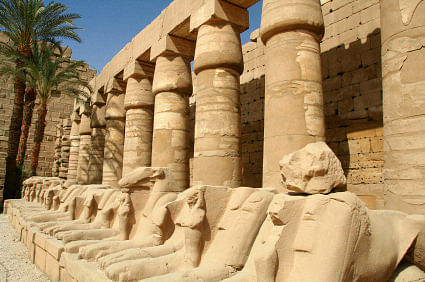
Karnak is the modern-day name for the ancient site of the Temple of Amun at Thebes, Egypt. The Egyptians called the site Nesut-Towi, "Throne of the Two Lands", Ipet-Iset, "The Finest of Seats" as well as Ipt-Swt, "Selected Spot" (also given as Ipetsut, "The Most Select of Places"). The original name has to do with the ancient Egyptian belief that Thebes was the first city founded on the primordial mound which rose from the waters of chaos at the beginning of the world. At that time, the creator-god Atum (sometimes Ptah) stood on the mound to begin the work of creation. The site of the temple was thought to be this original ground and the temple was raised at this spot for that reason. Karnak is believed to have been an ancient observatory as well as a place of worship where the god Amun would interact directly with the people of earth.
HISTORICAL OVERVIEW
The Temple of Amun is the largest religious building in the world (though some claim Angkor Wat in Cambodia is larger) and honors not only Amun but other gods such as Osiris, Montu, Isis, Ptah and the Egyptian rulers who wished to be remembered for their contributions to the site. It was built gradually over the centuries, with each new ruler adding to it, from the beginning of the Middle Kingdom (2040 - 1782 BCE) through the New Kingdom (1570 - 1069 BCE) and throughout the Ptolemaic Dynasty (323 - 30 BCE). It has even been suggested that the rulers of the Old Kingdom (c. 2613 - c. 2181 BCE) first built there owing to the style of some of the ruins and the king's list of Old Kingdom monarchs inscribed by Tuthmose III (1458 - 1425 BCE) of the New Kingdom in his Festival Hall there. His choice of kings suggests that he may have removed their monuments to build his hall but still wanted them to be remembered. Structures were regularly removed, renovated, or expanded during the temple's long history. The complex continued to grow with each succeeding ruler and the ruins today cover over 200 acres of land. It has been estimated that one could fit three structures the size of Notre Dame Cathedral in the main temple alone.
The Temple of Amun was in constant use with perpetual growth for over 2,000 years and considered one of the most sacred sites in Egypt. The priests of Amun who oversaw the administration of the temple became increasingly wealthy and powerful to the point that they were able to take control of the government of Thebes toward the end of the New Kingdom when rule of the country became divided between theirs at Thebes in Upper Egypt and that of the pharaoh in the city of Per-Ramesses in Lower Egypt. The rise of the power of the priests, and the resulting weakness of the position of the pharaoh, is considered the major contributing factor in the decline of the New Kingdom and the beginning of the Third Intermediate Period (1069 - 525 BCE). The temple complex was damaged in the Assyrian invasion of 666 BCE and again by the Persian invasion of 525 BCE but, both times, was repaired and renovated.
IT HAS BEEN ESTIMATED THAT ONE COULD FIT THREE STRUCTURES THE SIZE OF NOTRE DAME CATHEDRAL IN THE MAIN TEMPLE ALONE.
By the 4th century CE Egypt was a part of the Roman Empire and Christianity was being promoted as the one true faith. The emperor Constantius II (337 - 361 CE) ordered pagan temples to be closed in 336 CE and the Temple of Amun was deserted.Coptic Christians made use of the building for church services, as evidenced by Christian art and inscriptions on the walls, but then the site was abandoned. It was rediscovered during the 7th century CE Arab Invasion of Egypt at which time it was called "Ka-ranak" which means 'fortified village' because of the enormous amount of architecture amassed in one area. When European explorers first began traveling in Egypt in the 17th century CE they were told the grand ruins at Thebes were those of Karnak and the name has been in use for the site since then.
AMUN & THE EARLY TEMPLE
Amun (also known as Amun-Ra) was a minor Theban deity who, after Mentuhotep II unified Egypt in c. 2040 BCE, rose in prominence. The powers of two older gods, Atum and Ra (the creator god and sun god, respectively) were combined in Amun, making him the supreme king of the gods, both creator and preserver of life. The area of Karnak may have already been sacred to Amun before any structures were built there or could have been sacred to Atum or Osiris, both of whom were also worshipped at Thebes. The site was already set apart as holy ground in that no evidence of domestic homes or of markets has been found there, only religiously-themed buildings or royal apartments constructed long after the first temple was constructed.As there was no separation of one's religious beliefs from one's daily life in ancient Egypt one might think that it would be hard to tell a purely secular building from a religious site but this is not so, or not always so. At Karnak the inscriptions left on the columns and walls, as well as the artwork, clearly identify the site as religious in nature from the earliest times.

Amun
The first monument thought to be raised at the site is that of Wahankh Intef II (c. 2112 - 2063 BCE) who erected a column to the honor of Amun-Ra. This claim has been contested by those scholars who point to the king's list of Thutmose III in his Festival Hall who claim the site was first developed for religious purposes in the Old Kingdom. They also sometimes point out Old Kingdom styles in some of the architecture of the ruins. The architectural link has no bearing on the claim, however, because the style of the Old Kingdom (the age of the great pyramid builders) was often emulated by later ages to invoke the grandeur of the past. If any Old Kingdom rulers built there then their monuments were removed by later kings and this is what some scholars claim Thutmose III's king list points to.
Wahankh Intef II was one of the Theban rulers who waged war against the ineffectual central government at Herakleopolis and paved the way for Mentuhotep II (c. 2061-2010 BCE) to overthrow the kings of the north and reunite Egypt under Theban rule.When Mentuhotep II came to power he built his mortuary complex directly across the river from Karnak at Deir el-Bahri and this has suggested to some scholars that a significant temple to Amun already existed there at this time; not just the monument of Wahankh Intef II. Mentuhotep II may have built a temple at the site to honor Amun for helping him achieve victory, and then built his complex across from it, but this claim is speculative and no evidence suggests it. Most likely he chose the site of his mortuary complex because of its proximity to the holy site across the river; there would not have had to be a temple on the spot at the time to motivate him.
The first known builder at Karnak is the king Senusret I (c. 1971-1926 BCE) of the Middle Kingdom who built a temple to Amun with a courtyard which may have been intended to honor, and mirror, Mentuhotep II's mortuary complex across the river.Senusret I, then, would have been the original architect of Karnak in response to the great hero Mentuhotep II's tomb. Any claims along these lines remain speculative, however, and all that is clearly known is that the area was considered sacred before any temple was constructed there.
The Middle Kingdom rulers who followed Senusret I all added their own touches to the temple and expanded on the site but the rulers of the New Kingdom would transform the modest temple grounds and buildings into a colossal complex of immense scope and detail. Nothing like Karnak had been attempted since the 4th Dynasty king Khufu (c. 2589-2566 BCE) built his Great Pyramid at Giza.
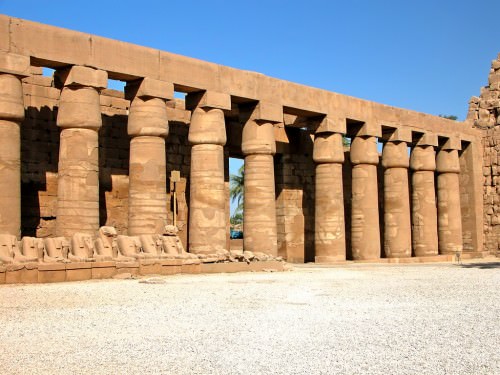
Temple of Amun, Karnak
THE NEW KINGDOM DEVELOPMENTS
The pharaohs of the New Kingdom lavished attention on the Temple of Amun. Seti I (1290-1279 BCE) and, especially, his successor Ramesses II (The Great, 1279-1213 BCE), added decorations and columns to the Hypostyle Hall which had been constructed to huge proportions previously in the New Kingdom. This was done to honor the god and ensure the pharaoh's place in the eternal remembrance of the people. Scholar Corinna Rossi, citing Egyptologist Elizabeth Blyth's work, writes:
The importance of Karnak resided in its being the contact point between Amun, the supreme ruler of the universe, and the pharaoh, the supreme ruler on Earth who represented all Egyptian people. Thus, especially from the New Kingdom onwards, every king who wished to be remembered forever was virtually compelled to contribute to the splendor of this most important temple (41).
All of the pharaohs of the New Kingdom, before and after Seti I and Ramesses II, contributed to Karnak. Actual labor on the site was accomplished by forced labor of inmates from the Great Prison at Thebes, individuals performing community service, or paid workers, masons, and artists. The New Kingdom began with the reign of Ahmose I (c. 1570 - 1544 BCE) who united Egypt after expelling the foreign rulers known as the Hyksos. Ahmose I, a Theban prince, thanked the god Amun for his victory by contributing to the temple at Karnak. Amenhotep III (1386 - 1353 BCE), who had one of the most luxuriant reigns in Egyptian history and whose many building projects guaranteed he would be remembered, still made sure to contribute to the Temple of Amun at Thebes. His successor, Akhenaten (1353 - 1336 BCE), banned the worship of Amun and the other gods of Egypt, closed all the temples, and elevated his personal god, Aten, to the level of the one supreme god of the universe. Even so, he still contributed to Karnak though his contribution was a temple to Aten, not Amun, which was destroyed by the later pharaoh Horemheb (1320 - 1295 BCE) when he restored the gods of Egypt and tried to wipe the memory of Akhenaten's reign from history. The result of these additions, renovations, and developments throughout the New Kingdom was an ever-increasing complex of immense size and scope. Historian Margaret Bunson writes:
Karnak remains the most remarkable religious complex ever built on earth. Its 250 acres of temples and chapels, obelisks, columns and statues built over 2,000 years incorporate the finest aspects of Egyptian art and architecture into a great historical monument of stone. It was designed in three sections. The first one extended from the northwest to the southwest, with the second part at right angles to the original shrine. The third section was added by later kings. The plan of the Temple of Amun, evident even in its ruined state, contained a series of well-coordinated structures and architectural innovations, all designed to maximize the strength of the stone and the monumental aspects of the complex. Karnak, as with all other major temples of Egypt, was graced with a ramp and a canal leading to the Nile and this shrine also boasted rows of ram-headed sphinxes at its entrance.At one time the sphinxes joined Karnak and another temple of the god at Luxor, to the south (133).
This huge complex, dedicated to Amun and a number of honorary gods and goddesses, had at its center the inner sanctum of the god's home which was perfectly aligned with sunset at the summer solstice. All of Karnak, in fact, is aligned with celestial events which would have been interpreted by the priests there to understand the will of the god and his wishes for humanity.
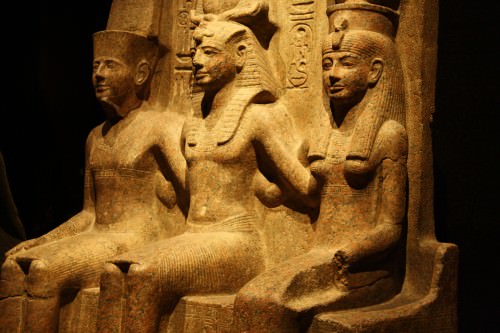
Amun, Ramesses II, & Mut
THE STRUCTURE & OPERATION OF THE SITE
Karnak is comprised of a series of pylons (monumental gateways which taper towards the top to cornices), leading into courtyards, halls, and temples. The first pylon opens onto a wide court which invites the visitor further. The second pylon opens onto the Hypostyle Court which measures 337 feet (103 meters) by 170 feet (52 meters). The hall is supported by 134 columns 72 feet (22 meters) tall and 11 feet (3.5 meters) around in diameter.
The god to whom the ground was originally dedicated may have been Montu, a Theban war god, and there was a precinct dedicated to him even after the rise of the cult of Amun. As the temple grew, however, it became divided into the three sections Bunson mentions above and dedicated to Amun, his consort Mut who symbolized the life-giving rays of the sun, and their son Khonsu, the moon god. These three gods became known as the Theban Triad and would be the most popular gods until the cult of Osiris with its triad of Osiris, Isis, and Horus overtook it (eventually becoming the Cult of Isis, the most popular in Egyptian history).
The temple complex grew from the original temple to Amun of the Middle Kingdom to an honorary site for many gods including Osiris, Ptah, Horus, Hathor, Isis and any other deity of note to whom the pharaohs of the New Kingdom felt they owed a debt of gratitude. The priests of the gods administered the site, collected tithes and gifts, dispensed food and counsel, and interpreted the gods' will for the people. There were over 80,000 priests employed at Karnak by the end of the New Kingdom and the high priests there were more wealthy than the pharaoh.
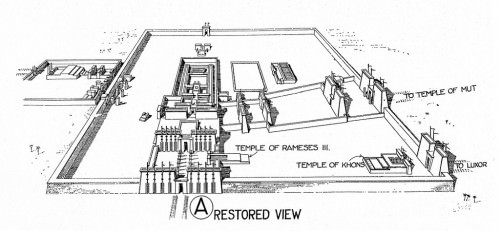
Temple of Amun Plan, Karnak
The cult of Amun caused problems for the monarchs of the New Kingdom from the reign of Amenhotep III onwards, probably earlier. Except for the half-hearted attempts of Amenhotep III and the dramatic reformation of Akhenaten, however, no ruler ever tried to do anything to significantly curb the priest's power and, as noted, every king contributed to Amun's temple and the wealth of the Theban priests without pause.
Even during the disunity of the Third Intermediate Period (c. 1069 - 525 BCE), Karnak still commanded respect and the rulers of Egypt continued to add to it what they could. Toward the end of the Third Intermediate Period Egypt was invaded first by the Assyrians in 671 BCE under Esarhaddon and then in 666 BCE by Ashurbanipal and Thebes was destroyed, but not the Temple of Amun at Karnak. This same paradigm repeated itself in 525 BCE when the Persians invaded the country. The Assyrians, in fact, were so impressed by Thebes and its great temple they ordered the Egyptians to rebuild the city after they had destroyed it.
The Persians were driven from Egypt by the pharaoh Amyrtaeus (404 - 398 BCE) and Egyptian rule resumed; as did construction at Karnak. The pharaoh Nectanebo I (380 - 362 BCE) added an obelisk and a pylon (unfinished) to the temple and built a wall around the site, perhaps to protect it from any future invasions. Nectanebo I was one of the great monument builders of ancient Egypt who was also responsible for the Temple of Isis at Philae. He was one of the last native Egyptian kings of the country. When the Persians returned in 343 BCE Egypt lost its autonomy.

Kriosphinx
THE PTOLEMIES & THE COMING OF ROME
In 331 BCE Alexander the Great took Egypt from the Persians and, after his death, his general Ptolemy claimed the country as his share of Alexander 's empire. Ptolemy I (323 - 283 BCE) tried to blend Egyptian and Greek culture to create a harmonious, multi-national state but focused most of his attention on Alexandria. His later successor Ptolemy IV (221 - 204 BCE), however, turned his attention to Karnak and built a hypogeum there, an underground burial chamber, dedicated to the god Osiris. The Ptolemaic Dynasty began to unravel under his reign and no other rulers of this period made additions to the Karnak site. The dynasty ended with the death of Cleopatra VII (69 - 30 BCE) after which Egypt was taken by Rome.
The Romans also focused their attention on Alexandria and ignored Thebes and its temple. They sacked Thebes in the 1st century CE during or after a battle with the Nubians to the south and left the city in ruins. After this date, fewer and fewer people visited either the city or the temple.
In the 4th century CE, Christianity was adopted by the Roman Empire under Constantine the Great (306 - 337 CE) and the new faith, no longer persecuted, began to gain more power and wider acceptance. The emperor Constantius II (337 - 361 CE) closed all pagan temples in the empire which of course included Karnak but, by this time, Thebes was a ghost town with some few inhabitants living in the ruins. The Coptic Christians of the area used the Temple of Amun as a church in the 4th century CE but then abandoned it. The city and the temple complex were then left to decay.
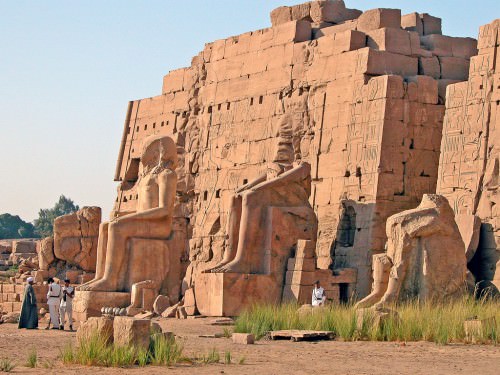
Hatshepsut's Temple, Karnak
In the 7th century CE the Arabs invaded Egypt and were the first to call the great structure "Karnak" because they believed it to be a fortified village ("el-Ka-ranak"). This was the name the local inhabitants gave to the early European explorers of the 17th century CE and the name the site has been known by since. Today Karnak is a great open air museum drawing thousands of visitors from around the world. It is one of the most popular tourist attractions in Egypt and among the most impressive ruins in the world. As with ancient sites like Baalbek, Stonehenge, the Great Pyramid, Nemrut Dag, Angkor Wat, and others, Karnak continues to fascinate visitors by its size, scope, and the possibilities of how the temple was built in a time without cranes, without trucks, without any of the modern technology which one considers so essential in the modern day. The history of Egypt from the Middle Kingdom through the 4th century CE is told on the walls and columns of Karnak and, as people today visit the site and see the inscriptions, they fulfill the hope of the monarchs of ancient Egypt that they would live forever through their great deeds recorded through their contributions to the Temple of Amun at Thebes.
Roman Egypt › Antique Origins
Definition and Origins

The rich lands of Egypt became the property of Rome after the death of Cleopatra VII in 30 BCE, which spelled the end of the Ptolemaic dynasty that had ruled Egypt since the death of Alexander the Great in 323 BCE. After the murder of Gaius Julius Caesar in 44 BCE, the Roman Republic was left in turmoil. Fearing for her life and throne, the young queen joined forces with the Roman commander Mark Antony, but their resounding defeat at the Battle of Actium in 31 BCE brought the adopted son and heir apparent of Caesar, Gaius Julius Octavius ( Octavian ), to the Egyptian shores. Desperate, Cleopatrachose suicide rather than face the humiliation of capture. According to one historian, she was simply on the wrong side of a power struggle.
EARLY RELATIONS WITH ROME
Rome's presence in Egypt actually predated both Julius Caesar and Octavian. The Romans had been involved periodically in Egyptian politics since the days of Ptolemy VI in the 2nd century BCE. The history of Egypt, dating from the ousting of the Persians under Alexander through the reign of the Ptolemys and the arrival of Julius Caesar, saw a nation suffer through conquest, turmoil, and inner strife. The country had survived for decades under the umbrella of a Greek -speaking ruling family. Although a center of culture and intellect, Alexandria was still a Greek city surrounded by non-Greeks. The Ptolemys, with the exception of Cleopatra VII, never traveled outside the city, let alone learn the native tongue. For generations, they married within the family, brother married sister or uncle married niece.
Ptolemy VI served with his mother, Cleopatra I, until her unexpected death in 176 BCE. Despite having serious troubles with a brother who challenged his right to the throne, he began a chaotic rule of his own. During his reign, Egypt was invaded twice between 169 and 164 BCE by the Seleucid king Antiochus IV; the invading army even approached the outskirts of the capital city of Alexandria; however, with the assistance of Rome, Ptolemy VI regained token control. While the next few pharaohs made little if any impact on Egypt, in 88 BCE the young Ptolemy XI succeeded his exiled father, Ptolemy X. After awarding both Egypt and Cyprus to Rome, Ptolemy XI was placed on the throne by the Roman general Cornelius Sulla and ruled with his step-mother Cleopatra Berenice until he murdered her. Ptolemy XI's ill-advised relationship with Rome caused him to be despised by many Alexandrians, and he was therefore expelled in 58 BCE. However, he eventually regained the throne but was only able to remain there through kickbacks and his ties to Rome.
When the Roman commander Pompey was soundly defeated by Caesar in 48 BCE at the Battle of Pharsalus, he sought refuge in Egypt; however, to win the favor of Caesar, Ptolemy VIII killed and beheaded Pompey. When Caesar arrived, the young pharaoh presented him with Pompey's severed head. Caesar reportedly wept, not because he mourned Pompey's death but supposedly had missed the chance of killing the fallen commander himself. Also, according to some sources, in his eyes, it was a disgraceful way to die. Caesar remained in Egypt to procure the throne for Cleopatra as Ptolemy's actions had forced him to side with the queen against her brother. With the defeat of the young Ptolemy, the Ptolemaic kingdom became a Roman client state, but immune to any political interference from the Roman Senate. Visiting Romans were treated well, even 'pampered and entertained' with sightseeing tours down the Nile. Unfortunately, there was no saving one Roman who accidentally killed a cat - sacred by tradition to the Egyptians - he was executed by a mob of Alexandrians.
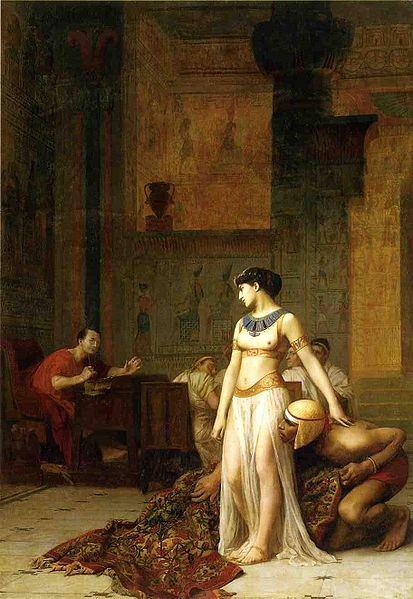
Cleopatra and Caesar
History and Shakespeare have recounted ad nauseum the sordid love affair between Caesar and Cleopatra; however, his unexpected assassination forced her to seek help in safeguarding her throne. She chose incorrectly; Anthony was not the one.His arrogance had brought the ire of Rome. Anthony believed Alexandria to be another Rome, even choosing to be buried there next to Cleopatra. Octavian rallied the citizens and Senate against Antony, and when he landed in Egypt, the young commander became the master of the entire Roman army. His victory over Antony and Cleopatra awarded Rome with the richest kingdom along the Mediterranean Sea. His future was guaranteed. The country's overflowing granaries were now the property of Rome; it became the 'breadbasket' of the empire, the 'jewel of the empire's crown.' However, according to one historian, Octavian believed that Egypt was now his own private kingdom, he was the heir of the Ptolemaic dynasty, a pharaoh.Senators were even prohibited from visiting Egypt without permission.
EGYPT BECOMES A ROMAN PROVINCE
With the end of a long civil war, Octavian had the loyalty of the army and in 29 BCE returned to Rome and the admiration of its people. The Republic had died with Caesar. With Octavian - soon to be acclaimed as Augustus - an empire was born. It was an empire that would overcome poor leadership and countless obstacles to rule for almost five centuries. He would restore order to the city, becoming its 'first citizen,' and with the blessing of the Senate, govern without question. Upon his triumphant march into the city, the emperor displayed the spoils of war. The conquering hero adorned in a gold -embroidered toga and flowered tunic rode through the city streets in a chariot drawn by four horses. Although Cleopatra was dead (he had hoped to display and humiliate her in public), an effigy of the late queen, reclining on a couch, was placed on exhibit for all to see. The queen's surviving children, Alexander Helios, Cleopatra Selene, and Ptolemy Philadelphus (Caesarion had been executed), walked in the procession. Soon afterwards, Augustus ordered the immediate construction of both a temple deifying Caesar (built on the spot where he had been cremated) and a new Senate house, the Curia Julia; the old one had been torched following Caesar's funeral.
THE COUNTRY'S OVERFLOWING GRANARIES WERE NOW THE PROPERTY OF ROME; IT BECAME THE 'BREADBASKET' OF THE EMPIRE, THE 'JEWEL OF THE EMPIRE'S CROWN.'
Emperor Augustus took absolute control of Egypt. Although Roman law superseded all legal Egyptian traditions and forms, many of the institutions of the old Ptolemaic dynasty remained with a few fundamental changes in its administrative and social structure. The emperor quickly filled the ranks of the administration with members of the equestrian class. With a flotilla on the Nile and a garrison of three legions or 27,000 troops (plus auxiliaries), the province existed under the leadership of a governor or prefect, an appointee (as were all major officials) of the emperor. Later, since the region saw few outside threats, the number of legions was reduced. Strangely, the first governor, Cornelius Gallus, unwisely made 'grandiose claims' about his victorious campaign into the neighboring Sudan. Augustus was not happy, and the governor mysteriously committed suicide - the area's frontier would thereafter remain fixed.
SOCIAL & CULTURAL DIVISIONS
Egyptian temples and priesthoods kept most of their privileges, although the imperial cult did make an appearance. While the mother-city of each region was permitted partial self-government, the status of many of the province's major towns changed under Roman occupancy with Alexandria (the city's population would reach 1,000,000) enjoying the greatest concessions.Augustus maintained a registry of the 'Hellenized' residents of each city. Non-Alexandrians were simply referred to as Egyptians. Rome also introduced a new social hierarchy, one with serious cultural overtones. Hellenic residents - those with Greek ancestry - formed the socio-political elite. The citizens of Alexandria, Ptolemais, and Naucratis were exempt from a newly introduced poll-tax while the 'original settlers' of the mother- cities were granted a reduced poll-tax.
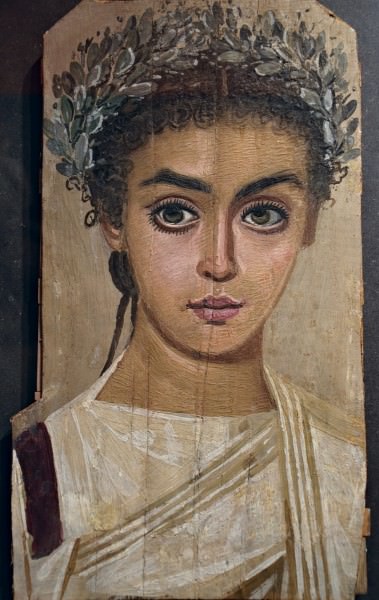
Mummy Portrait of a Girl
The main cultural separation was, as always, between the Hellenic life of the cities and the Egyptian-speaking villages; thus, the bulk of the population remained, as it had been, the peasants who worked as tenant farmers. Much of the food produced on these farms was exported to Rome to feed its ever-growing population. As it had for decades, the city needed to import food from its provinces – namely Egypt, Syria, and Carthage - to survive. The food, together with luxury items and spice from the east, ran down the Nile to Alexandria and then to Rome. By the 2nd and 3rd centuries CE, large private estates emerged operated by the Greek landowning aristocracy.
Over time this strict social structure would be questioned as Egypt, Alexandria especially, saw a significant change in its population. As more Jews and Greeks moved into the city, problems arose that challenged the patience of the emperors in Rome. The reign of Emperor Claudius (41-54 CE) saw riots emerge between the Jews and the Greek-speaking residents of Alexandria. His predecessor, Caligula, stated that the Jews were to be pitied, not hated. Later, under Emperor Nero (54-68 CE) 50,000 were killed when Jews tried to burn down Alexandria's amphitheater – two legions were necessary to quell the riot.
ATTITUDE TOWARDS ROMAN CONTROL
Initially, Egypt was accepting of Roman control. Its capital of Alexandria would even play a major role in the ascendancy of one of the empire's most famous emperors. After the suicide of Nero in 68 CE, four men would vie for the throne – Galba, Otho, Vitellius, and Vespasian – in what became known as the Year of the Four Emperors. In the end, the battle fell to Vitellius and Vespasian. With hopes of delaying valuable shipments of grain to Rome, Vespasian traveled to Alexandria. At the same time, Mucianus, a Roman commander and ally of Vespasian, marched into Rome. The defeated Vitellius was captured, and while pleading for his life, dragged through the streets, tortured, and killed. His body was thrown into the Tiber. Still in Alexandria, the armies of Vespasian unanimously declared him emperor.
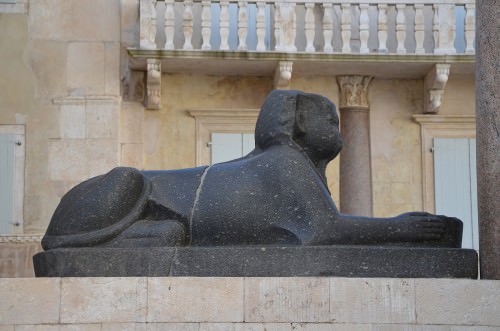
Egyptian sphinx from Diocletian's Palace
THE END OF ROMAN EGYPT
When emperor Diocletian came to power in the late 3rd century CE, he realized that the empire was far too big to be ruled efficiently, so he divided the empire into a tetrarchy with one capital, Rome, in the west and another, Nicomedia, in the east.While it would continue supplying grain to Rome (most resources were diverted to Syria), Egypt was placed in the eastern half of the empire. Unfortunately, a new capital in the east, Constantinople, became the cultural and economic center of the Mediterranean. Over time the city of Rome fell into disarray and susceptible to invasion, eventually falling in 476 CE. The province of Egypt remained part of the Roman/ Byzantine Empire until the 7th century when it came under Arab control.
LICENSE:
Article based on information obtained from these sources:with permission from the Website Ancient History Encyclopedia
Content is available under License Creative Commons: Attribution-NonCommercial-ShareAlike 3.0 Unported. CC-BY-NC-SA License